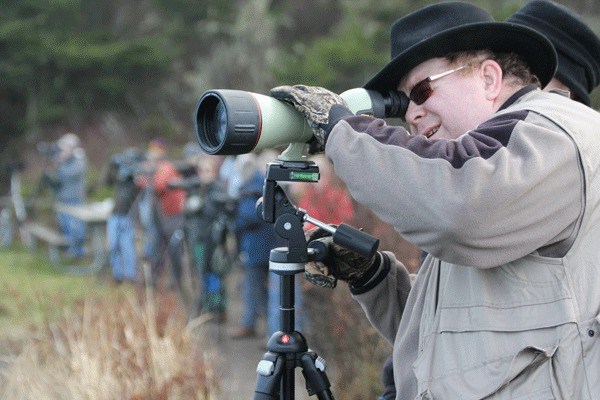As the fog lifted from West Beach parking lot at Deception Pass State Park, bird watchers pulled spotting scopes out of their cars and headed for the beach.
“This is the perfect light this morning,” Jo Reeves said.
It was around 9 a.m. on Saturday, and they were all there to try to spot the red throated loons that would be arriving soon.
More than 25 people attended the Loons at Deception Pass field trip put on by the Whidbey Audubon Society. Usually between eight to 12 bird watchers attend a trip.
“We’ve got a big group today,” said Joseph Sheldon, one of the trip leaders.
Reeves, another leader, made the trek from Freeland to come for outing.
“We kind of come from all over,” Reeves said.
Sarah Schmidt, one of the three leaders, said this annual field trip is usually one of the more popular events with birders. But finding a good day for this field trip can be a bit challenging sometimes.
The red throated loons like to come and feed at Deception Pass about 20 minutes before the Port Townsend high tide, and tides can fall around 6 a.m. or 3 p.m. which are not optimal times for trips, Schmidt said.
“It’s not easy to find a Saturday with an outflowing tide that hits in the morning,” Schmidt said.
The loons like to feed while the tide is flowing out. When this happens, dozens can be seen feasting in the seafood smorgasbord off shore.
“There’s some good feeding out there,” Schmidt said. “You get a sense of the current by watching the birds move along.”
The red throated is the smallest of the three loons found on Whidbey Island, Schmidt said. The other two are the common and the Pacific loon.
Red throated loons also separate themselves from the other two species because they can take off from small bodies of water. Loons cannot take off from land because of how their legs are positioned on their bodies. They are further back, which helps them propel through the water. If they don’t land on the water, they are unable to take flight.
“They can only scootch along,” Schmidt said.
They get into serious trouble when it’s been raining, Sheldon said. Roads and airstrips look like bodies of water and the loons will land on them.
“If they land, they cannot take off,” Sheldon said. “You have to get them to a large body of water so they can take off again.”
Pacific and common loons need larger bodies of water to pick up speed and take off, while the smaller red throat can take flight in less distance.
“They can spring into the air,” Schmidt said.
Its name is a misnomer this time of year though.
“They’re in winter plumage, so they are very white,” Schmidt said.
This is just one of the many field trips the Audubon Society hosts. It usually at least a couple field trips a month.
“Sometimes there are emergency trips,” Sheldon said. “Something is being seen and we just have to go out.”
The island is a great place to go birding because of all the Important Bird Areas. This designation by the Audubon Society means these sites provide essential habitat for one or more species of bird. This includes sites for breeding, wintering and/or migrating birds. Deception Pass is designated as an IBA, as well as other areas, such as Crockett Lake Crescent Harbor Marshes, Deer Lagoon, Penn Cove, Port Susan and Skagit Bay.
The birders didn’t just stick to the beach though. To warm up, the group took a walk by Cranberry Lake and through the campground. The trip leaders tried pishing — imitating an alarm sound — to see if any small birds would pop out of the woods. Schmidt cautioned attendees to be careful when using that technique though. It shouldn’t be used during breeding times, and it might lure females away from their nests leaving their offspring unprotected.
As they wandered around the park, attendees were able to help identify different species together, consulting their books as needed. Everyone used their expertise in the discussion.
And as the morning started to inch closer to noon, the birders and the red throated loons began to make their way out of Deception Pass State Park.
Upcoming field trips
The Whidbey Audubon Society’s next two field trips:
Feb. 4 at Deer Lagoon
The subjects will be ducks, shorebirds, some raptors and usually a few forest birds. Bring a spotting scope if you have one. Snow or ice may cancel this trip. Contact trip leader Phyllis Kind, 360-331-6337.
Feb. 15 at Skagit Flats
Look for winter birds of Skagit Flats, Fir Island, and Samish Flats.
Typically great concentrations of waterfowl and raptors — one of the top winter raptor viewing sites in the U.S. An all-day field trip. Snow or ice may cancel the trip. Contact trip leader Joe Sheldon, 360-678-9060.
For more information, go to www.whidbeyaudubon.org



